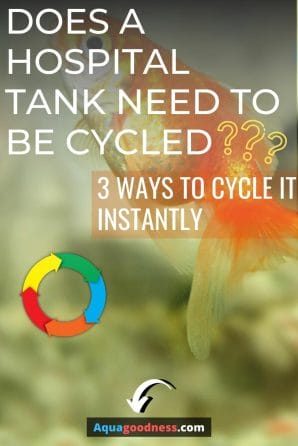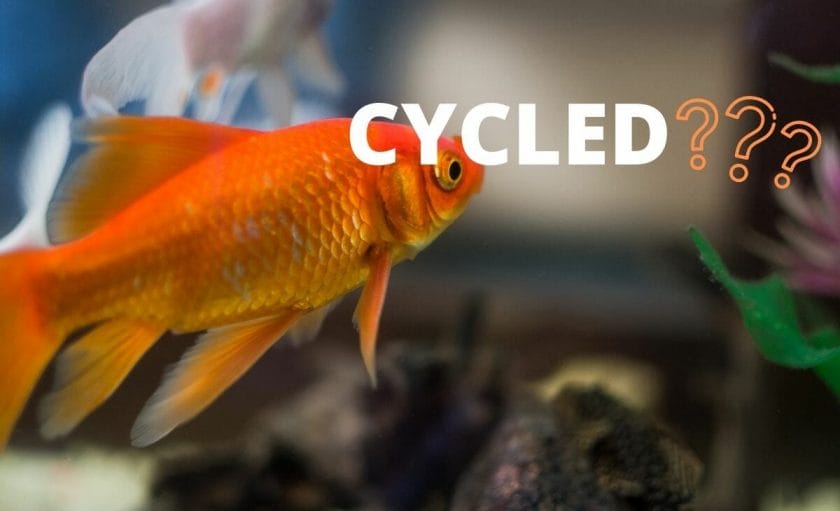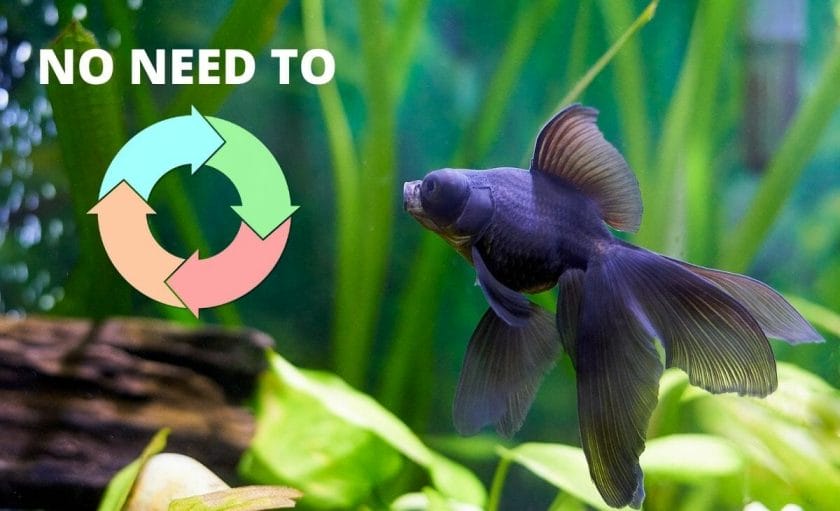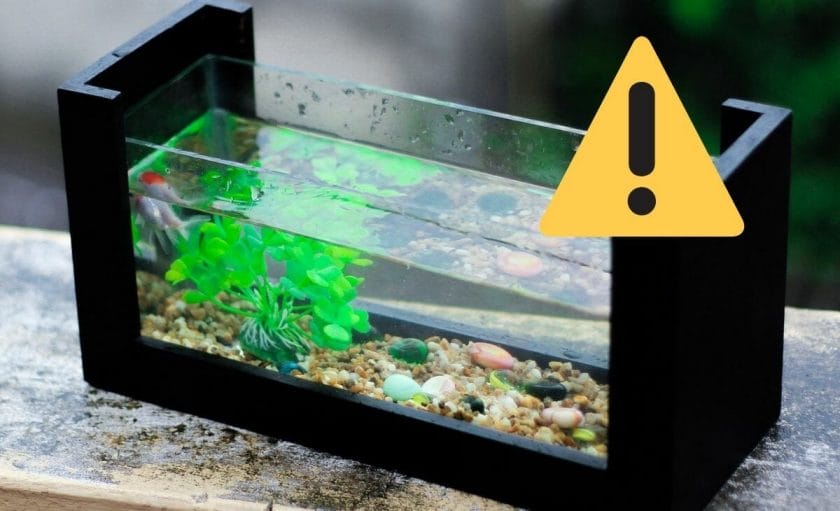A few months after setting up a single goldfish tank I was tempted to add another goldfish in the tank.
Just about I was going to get the new fish my experienced fishkeeper friend suggested me to quarantine the new fish in a hospital fish tank for at least a couple of weeks before putting it in the main tank.
Obviously, my next question was – does a hospital tank need to be cycled?
Ideally, you should cycle a hospital tank before putting the sick fish into the tank. However, some medications can remove biological filtration and you’ll need to do partial water changes on a daily basis in the hospital tank so you will not see ammonia levels in the tank.

Table of Contents
How to cycle a hospital tank instantly? (3 Easy ways)
There are three ways to cycle your hospital tank instantly.
1. Use a filter from an established or cycled aquarium
The filter media in your aquarium filter is a great place for beneficial bacteria to form their colonies.
Beneficial bacteria are the good bacteria that convert ammonia which is harmful to the fish into less harmful nitrite and then into nitrates.
So when you put a filter from an established tank into your hospital tank, the hospital tank now has beneficial bacteria. So the toxic ammonia that will be produced by fish waste and uneaten food will now be get converted into less toxic nitrites and nitrates.
To use this method, obviously, you will need to have at least two filters in your established or cycled aquarium. So you can put one of them in the hospital tank.
That’s why I always recommend having an extra sponge filter in a cycled aquarium.
An extra filter can also work as a backup in case your primary filter fails.
So what if you don’t already have two filters in your cycled aquarium?
No worries…
The next method of instantly cycling a fish tank is for you!
20 Tips to Maintain a Healthy Aquarium
2. Put filter media from an already cycled aquarium in the hospital tank
As I mentioned above, filter media is a great place for beneficial bacteria to form their colonies.
So, to instantly cycle your hospital tank, you’ll just need to replace the filter media of your hospital tank filter with the filter media from an established or cycled aquarium.
This will seed the beneficial bacteria in the hospital tank and your hospital tank will be instantly cycled!
Now you may be wondering, if you remove the filter media from an established tank then this will also remove the beneficial bacteria from the established tank. And it will affect the nitrogen cycle of the established tank.
And it probably will affect the nitrogen cycle in the established tank for a while.
But the fact is, beneficial bacteria grows throughout the aquarium in an established tank.
It grows on the glass wall, the substrate, the ornaments, and the live plants (if you have any).
So removing the filter media from the established tank will not cause any problem. Because though you’re removing some beneficial bacteria from the established tank, still, it already has a lot of beneficial bacteria.
Besides, the beneficial bacteria will soon populate on the new filter media.
3. Put gravel from a cycled aquarium in your hospital tank.
In an established or cycled aquarium, the beneficial bacteria will grow throughout the aquarium.
So if you already have a cycled aquarium then you can simply put some gravel from the cycled aquarium in your hospital tank to seed the beneficial bacteria in the hospital tank. This will instantly cycle your aquarium.
What Happens if You Don’t Cycle a Fish Tank?
How to keep a hospital tank cycled?

Generally, you don’t need to keep your hospital tank cycled.
Whenever you need to use your hospital tank, you just set it up by adding dechlorinated water into the tank, setting up a filter, and heater in the tank.
And to instantly cycle the tank you can use any of the methods I mentioned above.
Once you have treated the fish and you no longer need the hospital tank then you simply disinfect the hospital tank, dry it up, and store it.
However, if you want to keep your hospital tank cycled then you will need to add at least one fish into the hospital tank and keep the filter running in the tank.
Can I Use Fish Food to Cycle My Tank? (and How It Works)
Why you may not need to cycle your hospital tank?

There are a couple of reasons you may not need to cycle your hospital tank or if even if you cycle then tank it will be of no use.
1. Medications remove the beneficial bacteria
You set up a hospital tank for treating your ill fish.
And obviously, you will need to add some medications into the hospital tank to treat the fish.
Now there are some medications that remove the beneficial bacteria from the fish tank.
So, in this case, even if you cycle your hospital tank, the beneficial bacteria will get removed by the medications.
So technically, your fish tank will be uncycled.
2. Doing partial water changes
In a hospital tank, you will most likely need to do partial water changes on a daily basis.
Doing water changes on a daily basis removes the possibility of ammonia buildup in your hospital tank.
So, as the ammonia is not going to build up in your hospital tank because you’re doing water changes, it doesn’t need to be cycled.
Because the whole point of cycling a fish tank is to get rid of ammonia as it appears in a fish tank!
Will Live Plants Help Cycle My Tank?
Precautions you can take to avoid ammonia build up in an uncycled hospital tank

If you can’t put a filter or filter media from an established aquarium in your hospital tank to instantly cycle it.
Or the medications that you added in your hospital tank are going to remove the beneficial bacteria from your hospital tank then there is a possibility that the ammonia can build up in your hospital tank.
As ammonia is poisonous to the fish, it is very critical that you keep a close eye on ammonia levels in your hospital trank.
And do a water change as soon as you notice ammonia in your fish tank.
There are a couple of ways you can keep an eye on ammonia levels in your fish tank.
Let’s start with the common one.
1. Test kit
If you have an aquarium for some time then you most likely will have a test kit to test the water in your aquarium.
If you don’t then I highly recommend getting API master liquid test kit. It is very accurate.
You can check its reviews and latest price at Amazon here
So once you have set up the hospital tank, you should test the water in your hospital tank for ammonia levels on a daily basis.
If you noticed any ammonia then immediately do a partial water change to remove its concentration.
2. Seachem ammonia alert
Seachem ammonia alert is a very handy device that constantly measures the ammonia levels in your fish tank. And tells you if you have any ammonia levels in your fish tank.
You can check its reviews and latest price at Amazon here
This badge is really easy to use but you need to be careful while installing it in your fish tank. Or else, it will not work i.e. it will not show you accurate ammonia readings.
How to install Seachem ammonia alert (The right way)
First of all, open the packaging of the badge. Just make sure not to touch the middle circle of the badge because this is the part that senses the ammonia levels. And if you touch it then it may not show the ammonia readings accurately.
Once you removed the badge from the packaging remove the protective film from the badge. Again make sure not to touch the middle circle of the badge.
Now ideally, you should stick the badge in the fish tank before adding the fish to get accurate readings. Though you can put it in the tank anytime.
Sticking it into the fish tank is very easy. It has a suction cup so you just need to press it against the glass wall of your fish tank inside the fish tank and it’ll get stuck to the wall.
Once you installed the badge and added the fish in the fish tank, it will continuously monitor the ammonia levels in your fish tank.
The badge will take a maximum of 10 to 15 minutes to sense the ammonia levels in your tank.
It has four sections around the middle circle that goes as follows:
- Safe
- Alert
- Alarm
- Toxic
So as you may have already noticed “safe” is the one you want in your tank.
If the badge is showing Alert, Alarm, or Toxic reading then it suggests that your fish tank has ammonia.
In such case, you should do a partial water change to reduce the ammonia level in your fish tank.
Now one thing you should keep in mind is that it will take around four hours for the badge to reset itself.
So, for example, if the badge showed that your fish tank contains ammonia levels and you did a water change.
But, after doing the water change, the badge is still showing that the fish tank has ammonia.
This is because it will take about 4 hours for the badge to reset and show current, accurate reading again.
So this is just a thing to be aware of. Or else you would be doing water changes over and over again thinking your fish tank has ammonia in it!
You can check Seachem ammonia alert’s reviews and latest price at Amazon here
Conclusion
Ideally, your hospital tanks should be cycled before adding the fish in the tank.
However, some medications will remove the biological filtration from the tank anyways. And you are most likely going to need to do water changes on a daily basis so it should not be a problem if you don’t cycle your fish tank!
I hope this article has helped you.
If it does, please share it.
Happy fishkeeping!
Related article: